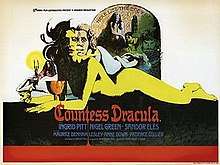Countess Dracula
Countess Dracula is a 1971 British Hammer horror film based on the legends surrounding the "Blood Countess" Elizabeth Báthory.
| Countess Dracula | |
|---|---|
 Theatrical release poster | |
| Directed by | Peter Sasdy |
| Produced by | Alexander Paal |
| Written by | Jeremy Paul |
| Starring | Ingrid Pitt Nigel Green Lesley-Anne Down |
| Music by | Harry Robertson |
| Cinematography | Kenneth Talbot |
| Edited by | Henry Richardson |
Production company | |
| Distributed by | Rank Film Distributors (UK) 20th Century Fox (US) |
Release date | |
Running time | 93 minutes |
| Country | United Kingdom |
| Language | English |
The film was produced by Alexander Paal and directed by Peter Sasdy, both Hungarian émigrés working in England. The original music score was composed by Harry Robertson. Countess Dracula was also released on a double bill with Vampire Circus.
Plot
In 17th-century Hungary, recently widowed Countess Elisabeth Nádasdy discovers that her youthful appearance and libido can be temporarily restored if she bathes in the blood of young women. She enlists her steward and lover Captain Dobi and her maid Julie to help with the kidnap and murder of several local girls, whilst having another sexual affair with a young Lieutenant, Imre Toth.
As a cover for her crimes while in her rejuvenated state, she takes the identity of her own daughter, Countess Ilona, whom she has Dobi hold captive in the woods. However, castle historian Fabio grows suspicious. Eventually, she kills a prostitute called Ziza, but her blood does not restore the Countess like the others. Dobi finds Fabio, who has a book-chapter about blood sacrifices and tells Elisabeth the truth in return for being allowed to live. He says only a virgin sacrifice will help Elisabeth remain young and beautiful.
She then kills more virgins, from peasant girls to the servant girls in the palace. Fabio tries to tell Toth the truth about his lover, but Dobi kills Fabio before he can do so. Dobi then shows Elisabeth to Toth to steer him away from her. Elisabeth forces Toth into marrying her, but her daughter Ilona arrives home, having been freed by a repentant Julie. Elisabeth grows old again and tries to kill her daughter, but accidentally kills Toth instead. Elisabeth, Dobi and her maid are sentenced to death for their crimes and are last seen awaiting the hangman in their cell. In the last scene, the peasants curse her as "devil woman" and "Countess Dracula".
Countess Dracula was based on Hungarian Countess Erzsebet Báthory (1560-1614), who was accused of murdering young girls, although this was not proved by the testimonies and false evidence.[3]
Cast
- Ingrid Pitt as Countess Elisabeth Nadasdy (Voice dubbed by Olive Gregg, uncredited)
- Nigel Green as Captain Dobi, the castle steward
- Sandor Elès as Lt. Imre Toth
- Maurice Denham as Grand Master Fabio, castle historian
- Patience Collier as Julie Szentes, the Nurse
- Lesley-Anne Down as Countess Ilona Nadasdy, Elisabeth's daughter
- Peter Jeffrey as Captain Balogh, chief bailiff
- Leon Lissek as Sergeant of Bailiffs
- Jessie Evans as Rosa, Teri's mother
- Andria Lawrence as Ziza, the whore at the Shepperd's Inn
- Susan Brodrick as Teri, the chambermaid
- Nike Arrighi as Fortune-telling gypsy girl
- Marianne Stone as Kitchen Maid
- Charles Farrell as The Seller
- Anne Stallybrass as Pregnant Woman
- Michael Cadman as Young Man
- Ian Trigger as Clown
- Alex Greenland (uncredited) as Choir Boy
Critical reception
Allmovie has retrospectively called the film "one of the more underrated films from the latter days of the Hammer Films dynasty."[4] The Hammer Story: The Authorised History of Hammer Films, on the other hand, wrote that the film's "distinctly anemic blood-lettings fail to lift a rather tiresome tale of court intrigue."[5]
New York Times film critic Howard Thompson considered it "better than most [horror movies] in a sea of trashy competition", and called Peter Sasdy's direction "smooth and pointed" with "crisp, cutting edge" dialogue, until the last act of the film where "it runs out of gas, along with the desperate old woman [Countess Elizabeth]."[6] David Pirie of The Monthly Film Bulletin called the acting "extremely poor," but found that the film "frequently takes on a nightmare quality" and that Pitt "brings to the part a very potent aura of physical corruption that is especially effective in the transformation sequences."[7]
Availability
The film is available on DVD from Metro-Goldwyn-Mayer in the USA as a double-bill with The Vampire Lovers, and from Carlton in the UK in a box set with Twins of Evil and Vampire Circus.
Synapse released a Blu-ray/DVD combo pack in the U.S. in 2014, which featured a new high-definition transfer.
See also
- Vampire film
- Cruelty and the Beast, a concept album by Cradle of Filth on which Pitt performs narration as Báthory.
References
- Meikle, Dennis (2009). A History of Horrors: The Rise and Fall of the House of Hammer (Revised Edition). Lanham, MD: Scarecrow Press, Inc. p. 255. ISBN 9780810863811.
- Smith, Gary A. (2017). Vampire Films of the 1970s: Dracula to Blacula and Every Fang Between. Jefferson, NC: McFarland & Company. pp. 64–65. ISBN 9781476625591.
- https://notesonhungary.wordpress.com/2014/05/31/the-bloody-countess/
- Donald Guarisco. "Countess Dracula - Review". Allmovie. Retrieved 8 July 2012.
- Hearn & Barnes 2007, p. 143.
- "Double Bill of Horror Arrives". New York Times. 12 October 1972. Retrieved 16 May 2013.
- Pirie, David (March 1971). "Countess Dracula". The Monthly Film Bulletin. 38 (446): 47.
Sources
- Hearn, Marcus; Barnes, Alan (25 September 2007). "Countess Dracula". The Hammer Story: The Authorised History of Hammer Films [The Hammer Story] (Limited ed.). Titan Books. ISBN 978-1845761851. OCLC 493684031.